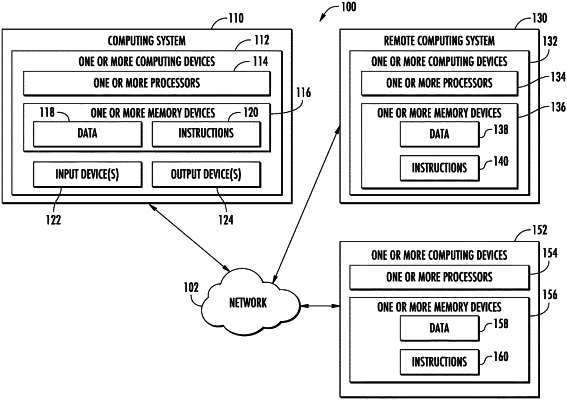| CPC G06Q 30/018 (2013.01) [G06F 16/9024 (2019.01); G06Q 10/105 (2013.01); G06Q 50/18 (2013.01)] | 20 Claims |

|
1. A computing system for determining compliance for an organization, the computing system comprising:
one or more processors;
a plurality of databases that store organizational data associated with an organization, wherein the organizational data includes:
a plurality of employee objects respectively associated with a plurality of employees of the organization,
compliance rule logic and one or more compliance parameters, wherein the one or more compliance parameters are decoupled from the compliance rule logic which is stored as an expression tree in a first database among the plurality of databases, separate from a second database among the plurality of databases which stores the one or more compliance parameters, and
a plurality of jurisdiction objects respectively associated with a plurality of jurisdictions; and
one or more non-transitory computer-readable media that collectively store instructions that, when executed by the one or more processors, cause the computing system to perform operations including:
accessing, from the organizational data, employee information associated with a first employee object from the plurality of employee objects,
in response to receiving information associated with one or more inputs to a user interface of a computing device selecting at least one of a first jurisdiction among the plurality of jurisdictions or one or more first compliance parameters among the one or more compliance parameters:
accessing, from the organizational data, jurisdictional information associated with a first jurisdiction object from the plurality of jurisdiction objects, the first jurisdiction object being associated with the first jurisdiction, and
importing the one or more first compliance parameters relating to the first jurisdiction object to generate, via the compliance rule logic and without causing a change to a codebase, one or more compliance rules parameterized for the first jurisdiction object, wherein the one or more compliance rules are defined based on the first jurisdiction object and the one or more first compliance parameters according to a relational operator and a plurality of operands, and the one or more compliance rules include query expressions that are expressed in a query language,
determining compliance with the one or more compliance rules parameterized for the first jurisdiction object with respect to the first employee object by evaluating the query expressions against a data object graph to return one or more query results, based on the employee information and the one or more first compliance parameters,
based on the determining, providing an output indicating whether the one or more compliance rules parameterized for the first jurisdiction object are being complied with, with respect to the first employee object, and
when the output indicates the one or more compliance rules parameterized for the first jurisdiction object are not being complied with, causing, by the computing system, access to be restricted to one or more computing resources to a first employee associated with the first employee object, or causing, by the computing system, one or more computing resources to restrict a work schedule associated with the first employee, until the computing system determines the one or more compliance rules are complied with.
|